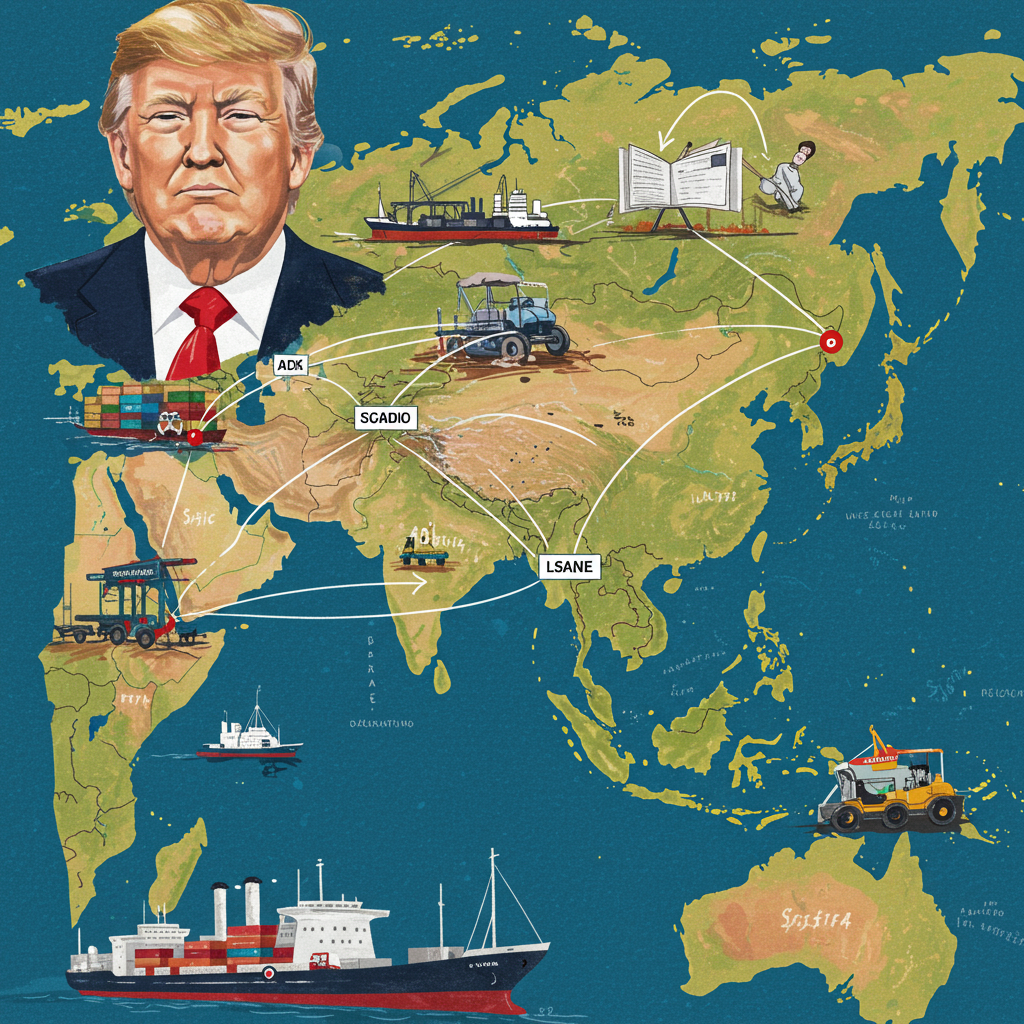Uncertainty reigns supreme for businesses operating in Asia. The unpredictable tariff policies enacted by former US President Donald Trump are forcing companies across the region to fundamentally rethink their strategies and operations. This isn’t just about minor adjustments; it’s a potential transformation of global supply chains and trade relationships, driven by fluctuating import taxes and geopolitical tensions.
Consider the experience of a major player in the semiconductor industry like GlobalFoundries. Tan Yew Kong, who oversees the company’s Singapore operations, likens their work to a tailor shop. They customize chips, providing everything from “fabric” to “cufflinks” based on client needs. But today, the customization extends beyond silicon; they are tailoring their entire future to navigate the volatile landscape created by Trump’s tariff approach.
The situation escalated ahead of deadlines like the one on July 9, marking the end of a 90-day pause on previously announced, steep “Liberation Day” tariffs. Despite countries and businesses scrambling to appease Washington, clarity remains elusive. President Trump has stated that letters detailing higher tariff rates, some potentially ranging from 10-20% up to a staggering 60-70% – higher than previously indicated maximums – would begin circulating, taking effect August 1. These letters, expected to number around a dozen, would notify specific countries, though the targets weren’t initially named. This uncertainty makes long-term business planning incredibly difficult. As Mr. Tan puts it, you cannot simply “flip the switch every other alternate week or day.”
While semiconductors initially enjoyed an exemption, threats have been made against the sector multiple times. Adding to the pressure, reports suggested plans to tighten controls on AI chip shipments to Malaysia and Thailand. This move aimed at preventing technology smuggling to China underscores the complex intersection of trade policy and national security concerns.
Asian economies are particularly vulnerable. They sit at the heart of global supply chains, serving as crucial links between major markets like China and the US. This deep integration means any disruption significantly impacts their trade patterns and economic stability. Professor Pushan Dutt of INSEAD highlights that shifts in these global supply chains pose much greater challenges for export-reliant nations like Singapore, Vietnam, and even China, compared to economies with large domestic demand like India.
The scope of threatened tariffs is broad, impacting not just high-tech but also traditional industries. Steep rates were initially proposed for long-time allies like Japan (24%) and South Korea (25%), and major trading partners like Vietnam (46%). While many rates were temporarily lowered to 10%, the threat of higher duties returning looms. Malaysian officials expressed concern about the adverse effects on textiles, furniture, rubber, and plastics. Singapore, despite its free trade deal with the US, faced a 10% levy, prompting its prime minister to question actions taken against a friend. South East Asian countries collectively represent a significant portion of global GDP (7.2% in 2024), meaning these extra costs could have severe, lasting consequences.
Different countries have reacted in varied ways. Vietnam managed to secure a specific deal, resulting in 20% US tariffs on its imports while US exports to Vietnam face no levies. Japan and South Korea entered trade negotiations, though Japan faced additional threats of up to 35% tariffs, severely impacting sectors like car manufacturing, with companies like Mazda reporting being in “survival mode.” Other nations like Indonesia and Thailand offered concessions, proposing to buy more US products or reduce taxes on American imports. Poorer countries like Cambodia, facing potentially staggering 49% tariffs with limited bargaining power, find it difficult to offer reciprocal purchases. Even key security allies like Australia argued their tariff rate “should be zero.”
Experts note that the previous push towards strategies like “friend-shoring” and “China + 1” – where companies diversified supply chains beyond China and Taiwan into Southeast Asia – was partly motivated by a desire to maintain access to the vital US market. The US remains the world’s largest economy and a crucial customer for many Asian businesses, regardless of tariff challenges.
However, US companies operating in Asia are not immune. Decades-long manufacturing relationships, like those in the clothing and footwear industry (e.g., Nike outsourcing to Vietnam and Indonesia), face increased costs due to tariffs on imported goods. These higher expenses are likely to be passed on to American consumers, contributing to inflation. Economists warn that these tariffs could trigger one of the most significant shifts in global trade in recent history, raising recession probability forecasts. Tibor Besedes, a trade expert, disputes the idea that consumers are willing to absorb higher costs, pointing to public concern over inflation during the previous administration.
The digital economy is also feeling the heat. Tariffs are expected to hit the e-commerce sector hard. Ian Bremmer of the Eurasia Group predicts pain for “online retailers… and consumer device brands.” A specific policy change, the end of the “de minimis” exemption for low-value packages from China and Hong Kong, adds another layer of complexity. This rule allowed goods under $800 to enter duty-free and was widely used by fast-fashion companies like Shein and Temu, as well as marketplaces like eBay and Etsy. Scrapping this could fundamentally alter online shopping, though implementation faces challenges like customs resource constraints.
Businesses are being forced to adapt to this volatile environment. Aparna Bharadwaj of Boston Consulting Group suggests companies rethink buffers, increasing inventory and lead times to cope with unpredictability. While this could uncover new opportunities, it may also impact competitiveness and market share in certain countries. The consensus among experts is that “uncertainty is the new normal.”
This shifting landscape is also influencing foreign investment flows within Asia. Capital could potentially move from countries facing high tariffs, such as Vietnam, Laos, and Cambodia under some proposals, towards those with lower rates or more stable trade relations, like the Philippines, Singapore, Malaysia, and Indonesia. Companies are actively seeking alternative export markets beyond the US, including the European Union, the Middle East, and Latin America.
The semiconductor sector provides a clear example of a broader trend: a move away from pure globalization towards regionalization. As Mr. Tan of GlobalFoundries notes, companies are looking for locations where they feel “safe,” where supply chain continuity is assured. This prioritization of security over cost means businesses and consumers may need to accept that goods will not be as cheap as they once were.
Paradoxically, the US embracing increased protectionism risks portraying it as an unreliable partner. This situation presents a significant opportunity for China to position itself as a guardian of the global trading order, especially as it strengthens trade ties with emerging Asian countries. While trade between China and the West slows due to tariffs, trade within Asia, particularly between China and Southeast Asian nations, is accelerating.
Jose Vinals of Standard Chartered suggests that while tariffs are negative for global growth, they are unlikely to escalate into a full-blown debilitating trade war, at least with China, where “super tariffs” (like 60%) are not expected. Instead, he foresees a major reshaping of global trade, predicting reduced trade between the US and the rest of the world, counterbalanced by an increase in trade among the rest of the world, particularly between Asia and regions like the Middle East, Africa, and Latin America. Hong Kong, in this new landscape, is seen as a critical “superconnector” between mainland China and the global economy.
Some experts, like Nick Vyas of USC’s Marshall School of Business, argue that strategically implemented tariffs, unlike what he perceives as current “emotional outbursts,” could benefit the US long-term by reducing reliance on China. He proposes a multi-tiered approach: building domestic capacity in critical sectors (semiconductors, defense) while continuing to outsource less strategic manufacturing, a process he estimates would take 3-5 years and requires a clear, consistent policy working with allies.
Ultimately, the trade turmoil initiated by Trump’s policies is driving a fundamental transformation of the global economic order. Businesses and economies in Asia are navigating this new reality, forced to adapt, diversify, and forge new paths. As Professor Dutt aptly summarizes, echoing an old proverb, they must “Bow to the ruler, and then go your own way.”
Frequently Asked Questions
What specific impacts are Trump’s tariffs having on Asian businesses?
Trump’s tariffs are causing widespread uncertainty, making long-term planning difficult for businesses in Asia, particularly those integrated into global supply chains like chip manufacturers, textile producers, and car part suppliers. Companies face higher costs, potential loss of competitiveness and market share, and disruptions requiring strategies like increasing inventory and lead times to build buffers against volatility. Investment flows within Asia are also being influenced, potentially shifting towards countries with lower tariff exposures.
Which Asian countries are most affected by Trump’s proposed tariffs?
Many Asian economies faced significant potential tariffs. Initial high rates were proposed for Japan (24%), South Korea (25%), and Vietnam (46%), though many were temporarily reduced to 10%. Countries like Malaysia and Singapore voiced concerns about broad industry impacts and bilateral relations. Poorer nations like Cambodia faced potentially staggering 49% rates with limited options. Vietnam secured a specific deal with lower US tariffs (20%). Japan faced additional threats (up to 35%), impacting sectors like auto manufacturing.
How are businesses in Asia adapting their strategies to Trump’s tariff policies?
Asian businesses are adopting several strategies. These include increasing inventory and lead times to manage unpredictability, seeking alternative export markets beyond the US (like the EU, Middle East, Latin America), and potentially relocating investment or parts of supply chains within Asia to countries with more favorable tariff conditions. The chip industry, for example, is shifting towards “regionalization,” prioritizing supply chain safety and continuity over lowest cost, recognizing that this new approach means goods will likely become more expensive.



